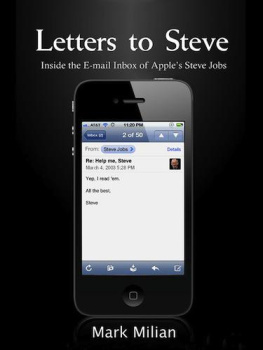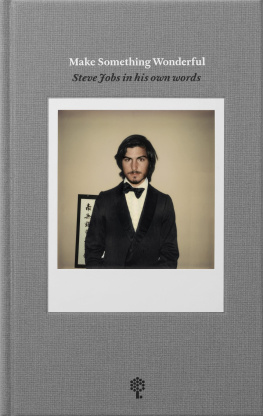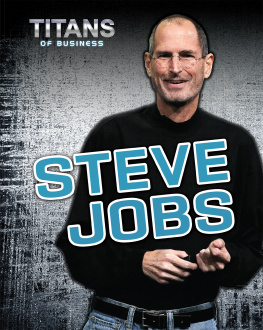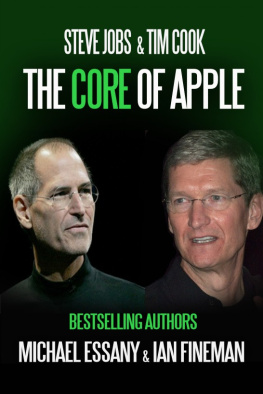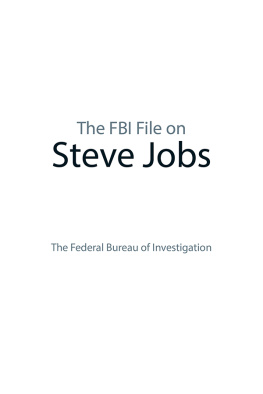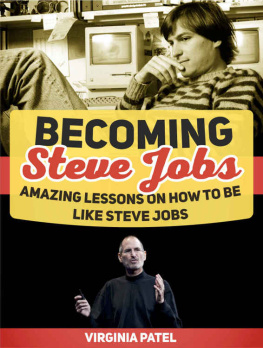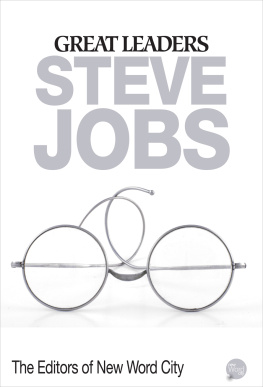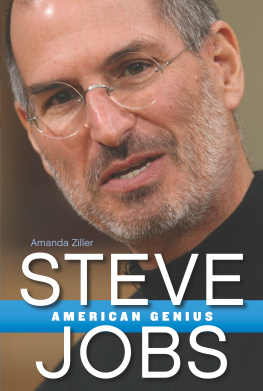Mark Milian - Letters to Steve: Inside the E-mail Inbox of Apples Steve Jobs
Here you can read online Mark Milian - Letters to Steve: Inside the E-mail Inbox of Apples Steve Jobs full text of the book (entire story) in english for free. Download pdf and epub, get meaning, cover and reviews about this ebook. year: 2011, publisher: Self published, genre: Detective and thriller. Description of the work, (preface) as well as reviews are available. Best literature library LitArk.com created for fans of good reading and offers a wide selection of genres:
Romance novel
Science fiction
Adventure
Detective
Science
History
Home and family
Prose
Art
Politics
Computer
Non-fiction
Religion
Business
Children
Humor
Choose a favorite category and find really read worthwhile books. Enjoy immersion in the world of imagination, feel the emotions of the characters or learn something new for yourself, make an fascinating discovery.
- Book:Letters to Steve: Inside the E-mail Inbox of Apples Steve Jobs
- Author:
- Publisher:Self published
- Genre:
- Year:2011
- Rating:3 / 5
- Favourites:Add to favourites
- Your mark:
- 60
- 1
- 2
- 3
- 4
- 5
Letters to Steve: Inside the E-mail Inbox of Apples Steve Jobs: summary, description and annotation
We offer to read an annotation, description, summary or preface (depends on what the author of the book "Letters to Steve: Inside the E-mail Inbox of Apples Steve Jobs" wrote himself). If you haven't found the necessary information about the book — write in the comments, we will try to find it.
Mark Milian: author's other books
Who wrote Letters to Steve: Inside the E-mail Inbox of Apples Steve Jobs? Find out the surname, the name of the author of the book and a list of all author's works by series.
Letters to Steve: Inside the E-mail Inbox of Apples Steve Jobs — read online for free the complete book (whole text) full work
Below is the text of the book, divided by pages. System saving the place of the last page read, allows you to conveniently read the book "Letters to Steve: Inside the E-mail Inbox of Apples Steve Jobs" online for free, without having to search again every time where you left off. Put a bookmark, and you can go to the page where you finished reading at any time.
Font size:
Interval:
Bookmark:
Letters to Steve
Inside the E-mail Inbox of Apples Steve Jobs
Mark Milian
Copyright
by 2011 Mark Milian
All rights reserved.
No part of this publication may be reproduced, transmitted or distributed in any form or by any means, electronic or mechanical, including photocopy, recording, or stored in a database or retrieval system, without the prior written consent of the copyright holder.
U.S. and international copyright laws protect such material.
Permissions for reproduction of any material in this publication may be submitted via e-mail to
No Warranties and Limitation of Liability
All statements about persons, companies, governments, places and other entities described in this publication are the subjective opinion of the author based on his understanding from personal observation, research and interviews. Others may disagree with these statements. Information in this publication is provided as is without warranty of any kind. The author used reasonable efforts to include accurate and up-to-date information herein. The author assumes no liability or responsibility for any errors or omissions in the content of this work.
This is a self-published book.
Cover design by Rudy Milian.
FWD
Dear Steve was the standard greeting. It was a boilerplate used in countless e-mails addressed to Steve Jobs, the late co-founder and longtime leader of Apple Inc. An unusual salutation, considering that few Americans in the age of the Internet start off their messages with dear and that the senders, almost always strangers, felt comfortable addressing this high-power executive so familiarly: Steve. Often, the letters were to ask for a new toy to replace one that had broken, for idle chitchat regarding topics Steve may have been interested in, or in the hopes of figuring out what he was working on in his workshop. Not saying was, as Steve liked to say, part of the magic, but he would give hints. Which is why the allure of e-mailing him, for many, was so difficult to resist.
The letters usually came from Steves fans or from irate Apple customers, who willingly conceded at some point in their missives that they, too, were fans of his. Other themes found in the content of these messages involve a skepticism about whether Steve actually read his e-mail and an even greater sense of doubt about whether he would personally respond to some random guys request. (Another man who receives a lot of fan mail, Santa Claus, has a fairly balanced male-to-female ratio, but as it turns out, Steves pen pals were invariably men.) More times than fans would expect, Steve did write back. His replies were typically succinct: Yep, Nope, I think so. But that brief confirmation, denial or textual shrug was enough to make the recipients day. For someone to open his inbox and find a message sent from the e-mail account of Steve Jobs was a heart-pumping moment. Once regaining composure, the lucky recipient often clicked forward and alerted the masses that he was a chosen one.
Then came the difficult task of deciding where the correspondence should be publicized. The blog Mac Rumors had been a top choice because the site and its Web forum are popular among Apple fans, and its easy to submit a tip to editors who will readily grant anonymity. For some reason, Steves one-time contacts routinely passed along messages under the condition that they not be named. If the purpose of that was to maintain a relationship with the executive, they should have considered that Steve also had a copy of what he wrote and likely had access to the search function in order to help him trace the informants identity. In the rush following a Steve chat, rationality often went out the window.
Apple is a company with many admirers. The Apple Stores are like temples, and people come in droves to their sort of mecca. Using MRI brain scans, neurological researchers interviewed by the BBC say that Apple zealots react in the same way to its products as religious believers do to their deities. People who use Mac computers are conditioned to call themselves Mac guys. A cell phone is just a phone, unless its an iPhone. (Apples marketing slogan in 2011 was, If you dont have an iPhone, well, you dont have an iPhone.) The iPad, which became the first mainstream tablet computer, is regarded as magical. Steve Jobs had said he coined that one.
The desire to be chosen by Steve out of what was surely a stream of hundreds, perhaps thousands, of messages per day was so intense that some publications had written articles purporting to have tips for soliciting a response. Business Insider composed a how-to slideshow on this topic, although the author never received a reply to his test message. A satirical site similar to the Onion but devoted entirely to Apple-related gags (no joke) called Scoopertino (the name comes from Apples home base in Cupertino, California) ran the headline: WikiLeaks releases 140,000 emails from Steve Jobs. Ironically, an Apple employee was cited, and Steve Jobs referenced, in cables from the U.S. embassy in China released by WikiLeaks in 2011. Authentic dispatches directly from the office of Steve Jobs were harder to come by.
However, other websites besides Mac Rumors have uncovered real scoops on Steve notes. AppleInsider wrote hard-news reports based on Steves e-mailed yeahs and nos. Cult of Mac , an aptly named site swimming in a sea of Web shrines to Apple, went after its own. Another blog, 9to5Mac , also managed to get exclusive notes. Additionally, members of the mainstream media, including Fortune , Gizmodo and Wired , strived to get e-mails from Steve first. There is even a blog dedicated, like this book, to Steve Jobs e-mails. It is appropriately called Emails from Steve Jobs , and it, too, has beaten other websites in publishing a handful of his messages.
Ive received a few as well. Some of the e-mails, at the time, did not seem newsworthy or could not be thoroughly and independently confirmed, and so I did not report on them. This book contains never-before-published e-mails from Steve Jobs, ones from my own archives and others that have surfaced through months of research. One of the messages I received includes the only on-the-record statement Apple has made about a widely-reported and apparently false assertion that the company joined a cabal to boycott Fox News Glenn Beck show.
The editors of the aforementioned blogs say they go to great efforts to verify the authenticity of these e-mails. They ask the sender to see headers, which contain a digital trail showing where the message traveled from. A computer analyst can compare the headers to known e-mails from Steve Jobs, although anyone who knows how to use Google could easily retrieve the same data and alter his forgery accordingly. Another strategy that Brian X. Chen, reporting for Wired , had used involves asking a source for the credentials to his e-mail account, and then logging in to see the e-mail exchange firsthand in its natural habitat. This is more difficult to fake, though not impossible.
In reality, there is no foolproof way to validate each of these e-mails. For many of the exchanges cited in this book, I have checked with reporters and alleged recipients of e-mails from Steve. Dubious messages were omitted. For the rest, like with Santa or magic, sometimes youve just got to believe.
Chapter 1
Return
Contrary to what Steve Jobs said about the iPad, theres nothing really magical about it. Its a computer, made of aluminum, glass and silicon, with a touchscreen. Tablets were around a decade before, and then after the iPad, Samsung Group, Sony Corp. and countless other electronics manufacturers have managed to clone Apples finger-friendly gadget with ease. The magic formula they havent been able to recreate, however, is Steve himself. Those companies lack a celebrity executive and with him, the cult that follows.
Next pageFont size:
Interval:
Bookmark:
Similar books «Letters to Steve: Inside the E-mail Inbox of Apples Steve Jobs»
Look at similar books to Letters to Steve: Inside the E-mail Inbox of Apples Steve Jobs. We have selected literature similar in name and meaning in the hope of providing readers with more options to find new, interesting, not yet read works.
Discussion, reviews of the book Letters to Steve: Inside the E-mail Inbox of Apples Steve Jobs and just readers' own opinions. Leave your comments, write what you think about the work, its meaning or the main characters. Specify what exactly you liked and what you didn't like, and why you think so.

